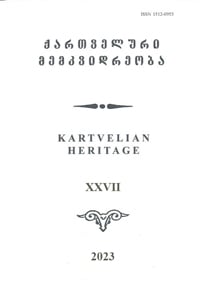THE STATE BORDER WITH CHOROKHI AND NARRATIVES OF BORDER SETTLEMENTS IN FICTION AND ORAL HISTORIES
Keywords:
Narratives of Georgia-Turkey border villages, narratives of KirnatiMaradidi, Georgia-Turkey relations , 20th centuryAbstract
The work draws from a diverse range of sources, including scientific literature, literary texts, and oral histories from villages (Kveda Maradidi, Zeda Maradidi, Kirnati, Kheba) located along the Georgia-Turkey border strip adjacent to the Chorokhi River (materials of the field expeditions of 2021-2023). The primary objective of this study is to explore specific thematic arcs that emerge from oral histories and fiction. Key areas of focus include narratives concerning demarcation and the border in generational memory, instances of smuggling, intelligence activities spanning the periods before, during, and after the World War II, as well as the dynamics of cross-border settlements and the evolution of communication methods. In the early 1920s, a significant geopolitical development unfolded as the state border between Turkey and the Soviet Union severed land and water connections, impacting valleys and villages in Georgia. A substantial portion of historical southern Georgia was incorporated into Turkey’s territory. Initially, until the mid-1930s, inhabitants living across the border maintained the ability to interact and traverse freely. However, over time, the border regime progressively tightened, particularly during and after the World War II. Notably, the dissolution of the Soviet Union marked a turning point in this situation. The timeliness of this research is underscored by its dual focus on the Chorokhi border settlements and the broader spatial transformation precipitated by the new border geography since the early 20th century. It’s worth highlighting that interest in narratives about state borders and border settlements has persisted throughout various eras, prompting numerous creators to engage with this subject matter. Consequently, the oral traditions of the Chorokhi basin contribute valuable material. The distinct nature of the border motif is predominantly informed by historical realities. In analytical texts, a discernible patriotic sentiment coexists with a palpable empathy for the plight of ordinary individuals, such as Sarpi, Maradidi, Kirnati residents, and others. This empathy resonates in depictions of the anguish felt for loved ones, as well as for the graves left behind on the opposite side of the border. Such emotions find expression in both the daily lives of border settlements and within literary works. However, it is important to recognize the influence of different epochs on the various forms of creative expression.

